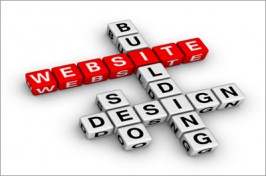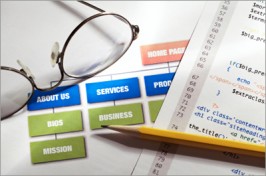When it comes to building a website, it helps to have a well defined process that you can follow, this will help ensure that the website design and development procedures consider all of the relevant aspects of the project. This in turn should result in well structured, relevant websites being created. Of course there is no point having a detailed process laid down that doesn’t involve creativity and allow it to flourish.
The Basics of the 4sWebs Website Design Process
This can be summed up in 6 steps:
 Learning
Learning- Planning
- Design
- Coding
- Launch
- Maintenance
Whilst the entire process will normally move forward in a step-wise fashion, there are nevertheless activities that continue to be carried out throughout the entire project ie. testing and obtaining feedback.
1. Learning
Having a good understanding of the aims of the website owners and the needs of the website visitors is fundamental to designing and developing an effective website. So it should come as no surprise that learning and discovering is a critical step. The more you know about what you need to accomplish, the better your chances will be of creating a successful website. What clients want varies widely and each project should be treated as unique. In some cases it is true to say that some owners don’t actually know what they want other than they know they need a web presence.
We nearly always visit clients to discuss their needs in order to discuss their ideas and learn about their business, organisation and the services and products that they provide. We gather information via a combination of completion of a website fact finder form and one-to-one discussion. At the end of this process we lay out a brief that identifies the scope and goals of the project and this is agreed with our client and this document provides the framework for the project’s website design and development.
The kind of issues that we address in our learning process include the following
- The client’s target audience
- Their primary goals for the website
- Current branding characteristics
- Like and dislikes in terms of styling
- Who the clients main competitors are
- Budget
- Deadlines they need to meet
2. Planning
Once we’ve learned what we need to build, we start planning how we are going to make it happen. This involves assessing the time-frames involved, the needs of the target audience and who currently satisfies that audience and how. Once we start to develop our plan we begin to consider the look and feel of the site and what is appropriate to the end-users and any corporate branding that exists. We often snap-shot other sites as we go along to inform our ideas.
and what is appropriate to the end-users and any corporate branding that exists. We often snap-shot other sites as we go along to inform our ideas.
At this point we normally generate a basic framework for how the website will be structured with the main functional areas and navigation being slotted into place and we also consider what tools we will need to use. In most cases, but not all, we would agree the basic framework with the client before proceeding with any of the website’s graphic design elements – this would be particularly relevant on complex, large build websites.
3. Designing
Whilst you might think designing is just about being creative this is not the case, but if you’ve already done the legwork of learning and planning, it makes the actual designing much easier and it opens up a whole new level of effectiveness and productivity because you can focus on clear objectives.
During the design phase we develop mock-ups of the main functional pages for the site – usually we do this first as an image but then when we are happy that all elements have a coherent look we convert our ideas to actual simple web pages so that we can show these mock-ups to our clients within a browser environment. At this point we would not normally include any functional coding as we are just intent on agreeing a basic design.
During the design phase, it is very important to get feedback often to make sure all specified requirements have been met and if the client needs to make changes these are agreed and done before the hard work of coding starts. It is much more difficult and time-consuming to modify the design once the coding has commenced.
4. Coding
Once we have our design we then start to turn it into a real, functional website. How we proceed from here will depend very much on what tools we are going to use and what functionality will be built into the site. We would normally start with laying out our basic page and style templates and then add text and images and build in any dynamic elements following this.
We feel it is important to ensure that we keep testing both in terms of any dynamic functionality but also to ensure that the code validates against the W3C standards. It is equally important to do browser testing to make sure that the web pages render correctly in various commonly used browsers and we continue to do this throughout the coding process.
As different functional areas are completed we release these to our clients to obtain their feedback and where necessary get some client/user-testing done so that we can ensure that the various elements are working as expected.
We would then build in any analytics coding that is required and prepare for the launch.
5. Launch
 When we’ve finished our main website design and development phase it’s time to release the site to the public and the search engines. This launch may also involve training for client end-users if they are going to be involved in maintaining the site or they are going to be handling data back from the website. We always release our websites manually to the search engines.
When we’ve finished our main website design and development phase it’s time to release the site to the public and the search engines. This launch may also involve training for client end-users if they are going to be involved in maintaining the site or they are going to be handling data back from the website. We always release our websites manually to the search engines.
6. Maintenance
During our planning phase, we will have determined who will be in charge of site updating/maintenance and if our clients do not wish to get directly involved in this activity then we will carry out any necessary work (with an appropriate fee being agreed for this ongoing work).
Our web design/development process has been in operation now for a number of years and we feel that it is well tried and tested. We do of course keep an eye on the ever-changing web environment and try to incorporate new trends and techniques as we progress.
As web designers we feel strongly that it is our job to marry an owner’s aims and goals with the end-users needs in the most effective way, whilst trying to ensure that we provide a cost-effective service to our client. If you are interested in our website design and development services why not look at the web services packages that we offer and please do not hesitate to contact us – we look forward to working with you.
